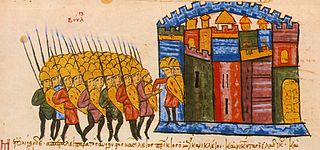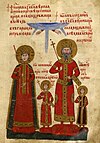Tsardom of Vidin
Tsardom of Vidin Видинско царство | |||||||||
|---|---|---|---|---|---|---|---|---|---|
| 1356–1365 1369–1422 | |||||||||
 The Tsardom of Vidin | |||||||||
| Capital | Vidin | ||||||||
| Common languages | Bulgarian | ||||||||
| Religion | Orthodox Christianity | ||||||||
| Government | Principality, Tsardom | ||||||||
| Historical era | Middle Ages | ||||||||
• Established | 1356 | ||||||||
• Disestablished | 1422 | ||||||||
| |||||||||
The Tsardom of Vidin (Template:Lang-bg, Vidinsko Tsarstvo) was a medieval Bulgarian state centred in the city of Vidin.
History
In 1257 the local lord Rostislav Mikhailovich was crowned as Tsar of Bulgaria in Tarnovo, but soon withdrew to Vidin.
By early 1290s Serbia expanded towards the vicinity of Vidin. Threatened by Serbian expansion, Shishman failed to repel the brothers forces, and accepted Serbian suzerainty.[1] Serbian rule lasted until Serbian king Stefan Milutin´s death, in 1321. As Milutin left no testament, after his death, in Serbia occurred a period of civil war with Stefan Dečanski, Stefan Konstantin and Stefan Vladislav II fighting for power. Shishman took advantage of this situation, set free from Serbian rule, and returned to Bulgarian orbit. In 1323 Shishman was chosen to be Bulgarian tsar. Shishman made an anti-Serbian treaty with the Byzantines, however, after Serbian victory over Bulgarians in the Battle of Velbazhd in 1330, Bulgaria lay militarily crippled and politically subordinated to Serbia's interests.[2]
In 1356, Bulgarian tsar Ivan Alexander isolated Vidin from the Bulgarian monarchy and appointed his son Ivan Stratsimir (1356–1396) as absolute ruler of the domain of Vidin.
In 1365, the state was occupied by Hungarian crusaders, but the occupation was short-lived. Although the initial campaign was not entirely successful because the Hungarians seized the city back, the ensuing negotiations between the Kingdom of Hungary and Ivan Alexander's allies, Vladislav I Vlaicu and Dobrotitsa, the despot of the semi-independent Dobrujan Principality of Karvuna, led to the return of the city to Bulgarian possession. It is thought that Ivan Sratsimir was reinstalled as the region's ruler in the autumn of 1369. In 1393 the whole of Bulgaria, along with the rest of the surrounding region, fell to the Ottoman Empire. This brought an end to Bulgaria's medieval state empire. Vidin was now the only region controlled by the indigenous Bulgarian population and not the invading Ottoman Turks.
The Ottomans went on to conquer the despotates of Dobruja, Prilep and Velbazhd as well. Vidin's independence did not last long. In 1396, Stratsimir contributed soldiers to assist the Christian nations' bid to overturn the Ottoman Empire. Following defeat at the hands of the Ottomans outside the city of Nicopolis, Vidin finally fell under the sphere of the Ottomans led by Murad II in 1422.[3][4]
Princes and Tsars of Vidin
- Shishman, tsar (self-proclaimed) (1280 — 1308), the founder of Shishman dynasty
- Michael I, prince (1308 — 1323), son of prince Shishman, elected to tsar of Bulgaria and uses the name Michael III.
- Belaur, prince (1323 — 1336), brother of prince Michael III, removed by Ivan Alexander.
- Ivan IV Asen, prince and co-tsar (1337 — 1349), son of tsar Ivan Alexander
- Michael IV Asen, prince and co-tsar (1337 — 1349), son of tsar Ivan Alexander
- Shishman II, claimant in exile
- Ivan Sratsimir, tsar (1356 — 1365), son of Bulgarian tsar Ivan Alexander
- Hungarian rule (1365 — 1369).
- Sratsimir, tsar (1369 — 1396) second reign
- Constantine II, tsar (1396 — 1422)
- Ottoman rule
References
- ^ The Balkans: From Constantinople to Communism by D. Hupchick, page 88
- ^ The Balkans: From Constantinople to Communism by D. Hupchick, page 89
- ^ A Concise History Of Bulgaria, Cambridge Concise Histories, R. J. Crampton, Cambridge University Press, 2005, ISBN 0521616379, p. 28.
- ^ The Late Medieval Balkans: A Critical Survey from the Late Twelfth Century to the Ottoman Conquest, John Van Antwerp Fine, University of Michigan Press, 1994, ISBN 0472082604, pp. 423-425.
Further reading
- Fine, Jr., John V.A. (1987). The Late Medieval Balkans. Ann Arbor: University of Michigan Press. ISBN 0-472-08260-4.
- Pavlov, Plamen. Car Konstantin II Asen — poslednijat vladetel na srednovekovna Bǎlgarija (in Bulgarian). LiterNet.








